AERQ: Leveraging IoT and HPC for Urban Air Quality Monitoring
Abstract
1. Introduction
1.1. Advances in Air Pollution Monitoring Technologies
1.2. Aim of the Research, Practical Relevance and Scientific Significance
2. Materials and Methods
2.1. Model Inter-Comparison
2.2. The Sardinian Case
The Cagliari Metropolitan Area
2.3. Application of AERMOD to Cagliari
Calibration of the Model
3. Results: The Decision Support System
3.1. Integrated Architecture for Multiscale Air Quality Modeling
3.2. Computational Core and High-Resolution Simulation Framework
3.3. User-Centric Applications and Decision-Making Tools
3.4. Application of the DSS
The Scenarios
4. Discussion
Reflections on the Use of the DSS
5. Conclusions
Author Contributions
Funding
Data Availability Statement
Conflicts of Interest
References
- WHO Air Pollution Information. Available online: https://www.who.int/news-room/fact-sheets/detail/ambient-(outdoor)-air-quality-and-health (accessed on 2 November 2024).
- EPA. Available online: https://www.epa.gov/mobile-source-pollution/learn-about-how-mobile-source-pollution-affects-your-health#mobile-sources (accessed on 1 August 2025).
- EEA Report 2023. Available online: https://www.eea.europa.eu/publications/europes-air-quality-status-2023 (accessed on 11 May 2025).
- Van Geffen, J.; Boersma, K.F.; Eskes, H.J.; Sneep, M.; ter Linden, M.; Zara, M.; Veefkind, J.P. S5P TROPOMI NO2 slant column retrieval: Method, stability, uncertainties and comparisons with OMI. Atmospheric Meas. Tech. 2020, 13, 1315–1335. [Google Scholar] [CrossRef]
- Chang, B.; Liu, H.; Zhang, C.; Xing, C.; Tan, W.; Liu, C. Relating satellite NO2 tropospheric columns to near-surface concentrations: Implications from ground-based MAX-DOAS NO2 vertical profile observations. NPJ Clim. Atmos. Sci. 2025, 8, 1. [Google Scholar] [CrossRef]
- De Santis, D.; Amici, S.; Milesi, C.; Muroni, D.; Romanino, A.; Casari, C.; Cannas, V.; Del Frate, F. Tracking air quality trends and vehicle traffic dynamics at urban scale using satellite and ground data before and after the COVID-19 outbreak. Sci. Total Environ. 2023, 899, 165464. [Google Scholar] [CrossRef] [PubMed]
- Gualtieri, G.; Brilli, L.; Carotenuto, F.; Cavaliere, A.; Giordano, T.; Putzolu, S.; Vagnoli, C.; Zaldei, A.; Gioli, B. Performance Assessment of Two Low-Cost PM2.5 and PM10 Monitoring Networks in the Padana Plain (Italy). Sensors 2024, 24, 3946. [Google Scholar] [CrossRef] [PubMed]
- Askariyeh, M.H.; Kota, S.H.; Vallamsundar, S.; Zietsman, J.; Ying, Q. AERMOD for Near-Road Pollutant Dispersion: Evaluation of Model Performance with Different Emission Source Representations and Low Wind Options. Transp. Res. Part Transp. Environ. 2017, 57, 392–402. [Google Scholar] [CrossRef]
- Munir, S.; Mayfield, M.; Coca, D.; Mihaylova, L.S.; Osammor, O. Analysis of Air Pollution in Urban Areas with Airviro Dispersion Model—A Case Study in the City of Sheffield, United Kingdom. Atmosphere 2020, 11, 285. [Google Scholar] [CrossRef]
- Available online: https://www.isprambiente.gov.it/en/archive/ispra-events/2024/02/presentation-of-the-air-quality-report-2023-edition (accessed on 11 May 2025).
- Colonne. Available online: https://www.9colonne.it/454521/breath-of-fresh-air-italy-s-remarkable-progress-in-air-quality?utm_source=chatgpt.com (accessed on 11 April 2025).
- Air Assessment. Available online: https://www.isprambiente.gov.it/en/activities/air/events-and-news (accessed on 11 April 2025).
- Eu Air Quality Directive. Available online: https://environment.ec.europa.euh/topics/air/air-quality/revision-ambient-air-quality-directives_en?utm_source=chatgpt.com (accessed on 11 May 2025).
- Xiao, Q.; Zhang, Z.; Liu, F.; Wu, Y.; Chang, H.H. Synergistic Effects of Ambient PM2.5, NO2, and Ozone on Mortality in 398 Cities. Environ. Int. 2024, 188, 108236. [Google Scholar]
- Meng, X.; Ma, Y.; Liu, C.; Chen, R.; Zhou, M.; Kan, H. A Multi-City Study of the Acute Effect of Carbon Monoxide on Mortality in China. Sci. Total Environ. 2024, 914, 168275. [Google Scholar] [CrossRef]
- European Environment Agency. Cagliari Among the Ten Italian Cities with the Worst Air Quality. L’Unione Sarda. 2024. Available online: https://www.unionesarda.it/en/sardinia/pollution-and-fine-particles-cagliari-among-the-ten-italian-cities-with-the-worst-air-quality-fruddzw1 (accessed on 21 July 2025).
- Cimorelli, A.J.; Perry, S.G.; Venkatram, A.; Weil, J.C.; Paine, R.J.; Wilson, R.B.; Lee, R.F.; Peters, W.D.; Brode, R.W. AERMOD: A Dispersion Model for Industrial Source Applications Part I: General Model Formulation and Boundary Layer Characterization. Appl. Meteorol. Climatol. 2005, 44, 682–693. [Google Scholar] [CrossRef]
- Pandey, G.; Venkatram, A.; Arunachalam, S. Modeling the air quality impact of aircraft emissions: Is area or volume the appropriate source characterization in AERMOD? Air Qual. Atmos. Health 2024, 17, 1425–1434. [Google Scholar] [CrossRef]
- Carruthers, D.J.; Stocker, J.R.; Ellis, A.; Seaton, M.D.; Smith, S.E. Evaluation of an explicit NOx chemistry method in AERMOD. J. Air Waste Manag. Assoc. 2017, 67, 702–712. [Google Scholar] [CrossRef] [PubMed]
- EPA AERMET User’s Guide. 2019. Available online: https://gaftp.epa.gov/Air/aqmg/SCRAM/models/met/aermet/aermet_userguide.pdf (accessed on 1 December 2024).
- Macêdo, M.F.M.; Ramos, A.L.D. Vehicle atmospheric pollution evaluation using AERMOD model at avenue in a Brazilian capital city. Air Qual. Atmos. Health 2020, 13, 309–320. [Google Scholar] [CrossRef]
- Rezaali, M.; Fouladi-Fard, R.; Karimi, A. Assessment of AERMOD and ADMS for NOx dispersion modeling with a combination of line and point sources. Stoch. Environ. Res. Risk Assess 2025. Advance online publication. [Google Scholar] [CrossRef]
- Nath, A.; Dhal, G.C. CALINE4 and AERMOD modelling for roadway vehicle-related air pollution: A recent review in India. Environ. Sci. Pollut. Res. 2024, 1–11. [Google Scholar] [CrossRef]
- Zeydan, Ö.; Karademir, A. Comparison of two air quality models in complex terrain near seashore. Atmósfera 2023, 37, 113–130. [Google Scholar] [CrossRef]
- Zhang, R.; Li, M.; Ma, H. Comparative study on numerical simulation based on CALPUFF and wind tunnel simulation of hazardous chemical leakage accidents. Front. Environ. Sci. 2022, 10, 1025027. [Google Scholar] [CrossRef]
- Air Emissions Factors and Quantification |USEPA. Available online: https://www.epa.gov/air-emissions-factors-and-quantification (accessed on 1 November 2024).
- Appel, K.W.; Bash, J.O.; Fahey, K.M.; Foley, K.M.; Gilliam, R.C.; Hogrefe, C.; Hutzell, W.T.; Kang, D.; Mathur, R.; Murphy, B.N.; et al. The Community Multiscale Air Quality (CMAQ) model versions 5.3 and 5.3.1: System updates and evaluation. Geosci. Model Dev. 2021, 14, 2867–2897. [Google Scholar] [CrossRef]
- Appel, K.W.; Napelenok, S.L.; Foley, K.M.; Pye, H.O.; Hogrefe, C.; Luecken, D.J.; Bash, J.O.; Roselle, S.J.; Pleim, J.E.; Foroutan, H.; et al. Description and evaluation of the Community Multiscale Air Quality (CMAQ) modeling system version 5.1. Geosci. Model Dev. 2017, 10, 1703–1732. [Google Scholar] [CrossRef]
- Zhu, Q.; Schwantes, R.H.; Coggon, M.; Harkins, C.; Schnell, J.; He, J.; Pye, H.O.; Li, M.; Baker, B.; Moon, Z.; et al. A better representation of volatile organic compound chemistry in WRF-Chem and its impact on ozone over Los Angeles. Atmos. Chem. Phys. 2024, 24, 5265–5286. [Google Scholar] [CrossRef]
- Manders, A.M.M.; Builtjes, P.J.H.; Curier, L.; Denier van der Gon, H.A.C.; Hendriks, C.; Jonkers, S.; Kranenburg, R.; Kuenen, J.J.P.; Segers, A.J.; Timmermans, R.M.A.; et al. Curriculum vitae of the LOTOS–EUROS (v2.0) chemistry transport model. Geosci. Model Dev. 2017, 10, 4145–4173. [Google Scholar] [CrossRef]
- Kim, S.-H.; Park, S.-H.; Joo, H.-S.; So, M.-S.; Lee, N.-H. A Study on Improvement of Air Quality Dispersion Model Application Method in Environmental Impact Assessment (II)—Focusing on AERMOD Model Application Method. J. Environ. Impact Assess. 2023, 32, 203–213. [Google Scholar] [CrossRef]
- Sardegnalive. Available online: https://www.sardegnalive.net/in-sardegna/aria-pulita-in-sardegna-biossido-di-azoto-e-ozono-nei-limiti-cygm08to (accessed on 11 March 2025).
- Seidel, D.J.; Free, M. Diurnal and seasonal variations in lower-tropospheric temperature inversions: Global climatology using radiosonde data. J. Geophys. Res. Atmos. 2020, 125, e2019JD030972. [Google Scholar]
- Air Quality Daily Data—Regione Autonoma Sardegna. Available online: https://www.sardegnaambiente.it/arpas/attivita/monitoraggio/aria/datigiornalieri.html (accessed on 12 January 2025).
- SOGAER. Available online: https://assaeroporti.com/archivio/ (accessed on 6 June 2025).
- Port Authority of Cagliari. Available online: https://www.adspmaredisardegna.it/cagliari/ (accessed on 1 September 2025).
- Data—Istat. Available online: https://www.istat.it/en/data/ (accessed on 1 August 2024).
- Cagliari API Portal. Available online: http://dashboard-api.comune.cagliari.it.s3-eu-west-1.amazonaws.com/traffic/pages/index.html (accessed on 1 August 2024).
- Intergovernmental Panel on Climate Change (IPCC). 2019. 2019 Refinement to the 2006 IPCC Guidelines for National Greenhouse Gas Inventories: Volume 2–Energy. Available online: https://www.ipcc.ch/report/2019-refinement-to-the-2006-ipcc-guidelines-for-national-greenhouse-gas-inventories/ (accessed on 21 January 2025).
- The Contribution of Transport to Air Quality-TERM12: Transport Indicator Tracking Progress Towards Environmental Targets in Europe-European Environment Agency. Available online: https://www.eea.europa.eu/en/analysis/publications/transport-and-air-quality-term-2012 (accessed on 5 May 2025).
- Salva, J.; Vanek, M.; Schwarz, M.; Gajtanska, M.; Tonhauzer, P.; Ďuricová, A. An Assessment of the On-Road Mobile Sources Contribution to Particulate Matter Air Pollution by AERMOD Dispersion Model. Sustainability 2021, 13, 12748. [Google Scholar] [CrossRef]
- Cau, P.; Muroni, D.; Satta, G.; Milesi, C.; Casari, C. AERQ—A Web-Based Decision Support Tool for Air Quality Assessment. Appl. Sci. 2025, 15, 2045. [Google Scholar] [CrossRef]
- Haklay, M.; Weber, P. Open Street Map: User-Generated Street Maps. IEEE Pervasive Comput. 2008, 7, 12–18. [Google Scholar] [CrossRef]
- Wendlik, V.; Karut, I.; Behr, F. Tiling concepts and tile indexing in Internet mapping APIs. In Geoinformation for a Better World: Applied Geoinformatics for Society and Environment; Behr, F., Ngigi, M., Pradeepkumar, A.P., Zimmermann, M., Eds.; AGSE: Nairobi, Kenya, 2011; pp. 116–121. [Google Scholar]
- Pérez, K.; Palència, L.; López, M.J.; León-Gómez, B.B.; Puig-Ribera, A.; Gómez-Gutiérrez, A.; Nieuwenhuijsen, M.; Carrasco-Turigas, G.; Borrell, C. Environmental and Health Effects of the Barcelona Superblocks. BMC Public Health 2025, 25, 634. [Google Scholar] [CrossRef]
- Sannino, A.; De Martino, A.; De Gennaro, G.; Di Gennaro, S.; De Santis, F.; Di Leo, E.; Di Carlo, P.; De Gennaro, M.; Di Gennaro, F.; De Gennaro, S.; et al. Air Quality Improvement Following the COVID-19 Pandemic Lockdown in Naples, Italy: A Comparative Analysis (2018–2022). Environments 2024, 11, 167. [Google Scholar] [CrossRef]
- Fioravanti, G.; Sannino, A.; De Martino, A.; De Gennaro, G.; Di Gennaro, S.; De Santis, F.; Di Leo, E.; Di Carlo, P.; De Gennaro, M.; Di Gennaro, F.; et al. Long-Term Variation in Exposure to NO2 Concentrations in Naples, Italy. Environ. Sci. Technol. 2024, 58, 12345–12354. [Google Scholar]
- Air Quality in Nice. 2023. Available online: https://www.investincotedazur.com/en/air-quality-in-nice-significant-reduction-in-fine-particle-pollution/ (accessed on 20 October 2025).
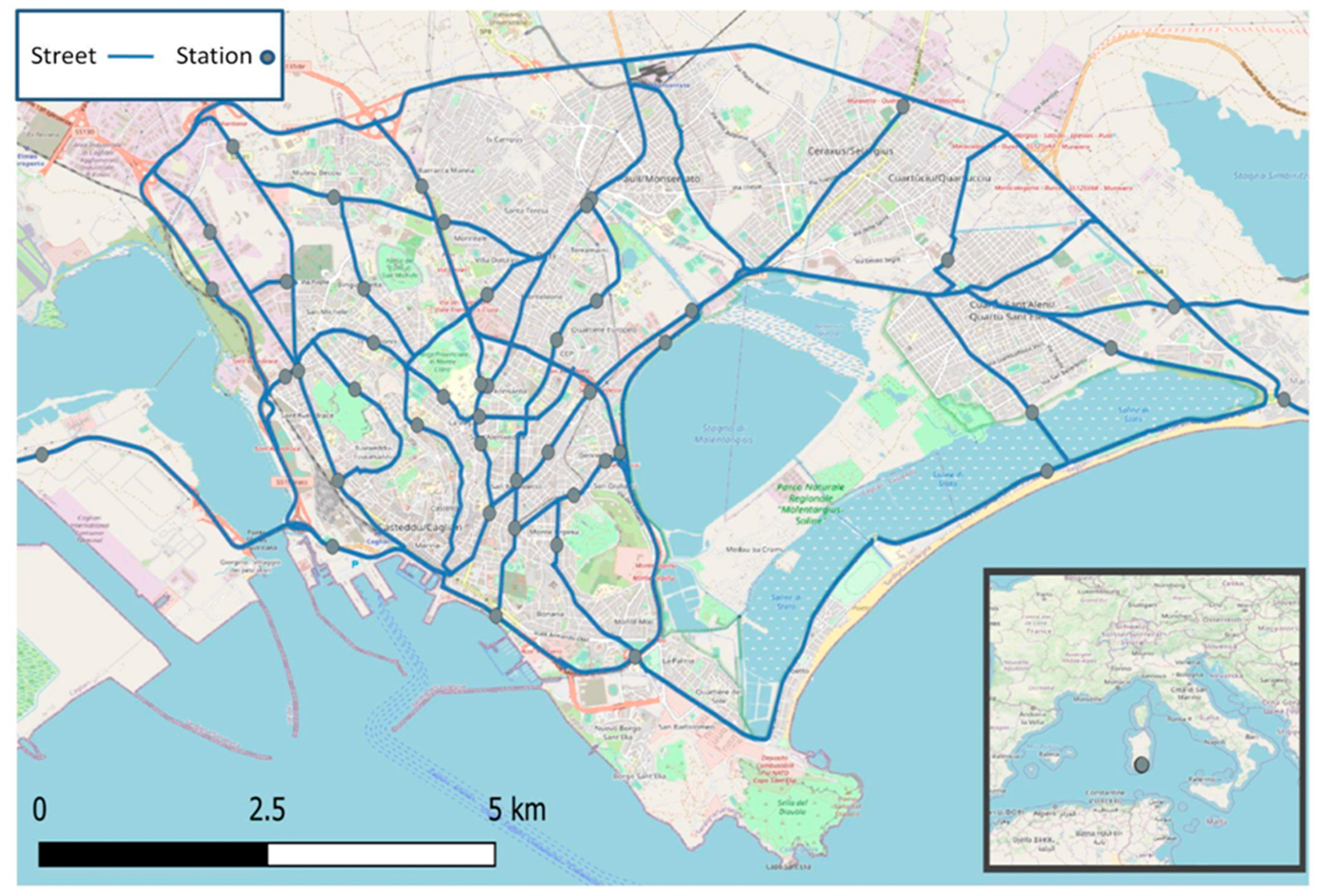
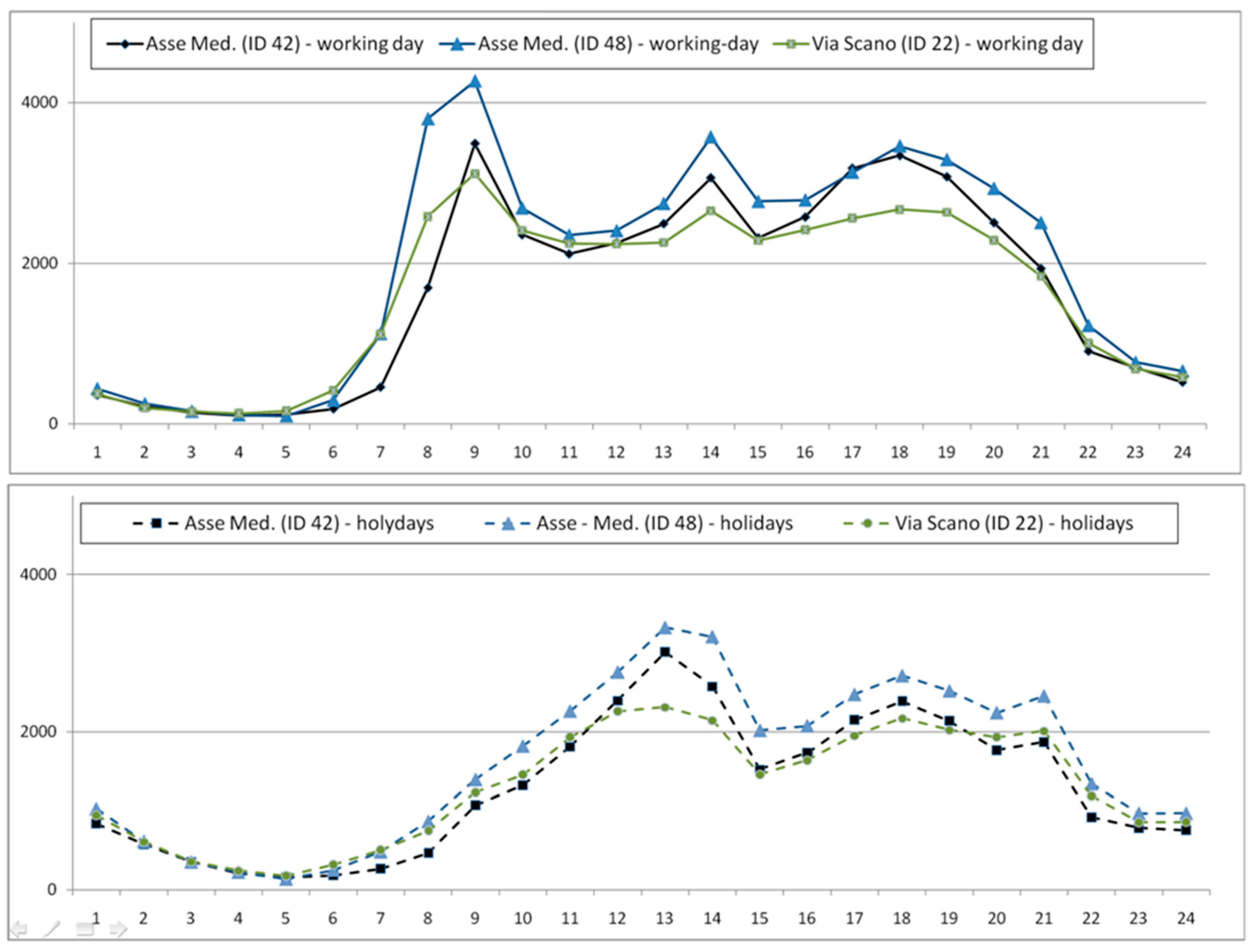
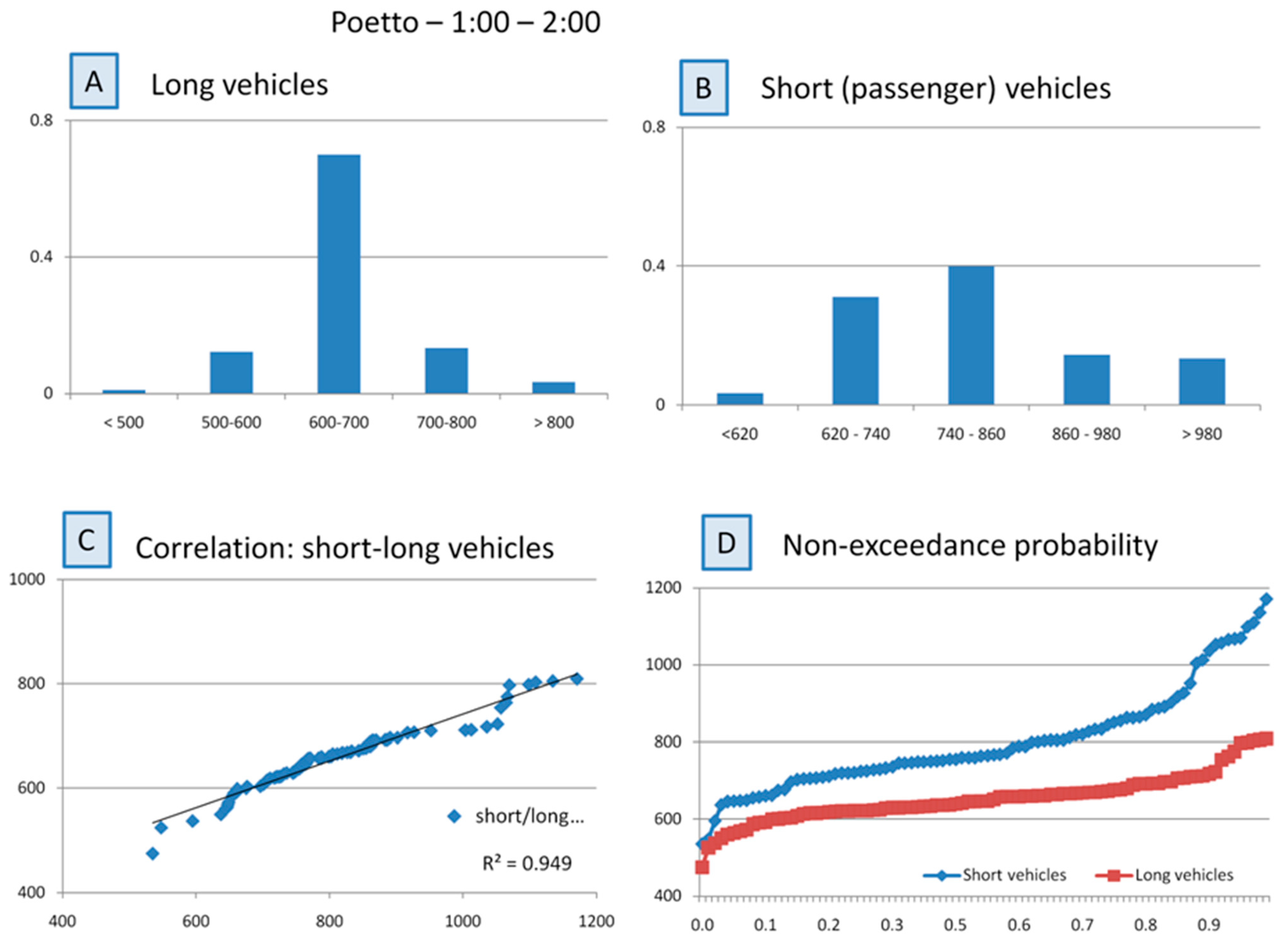



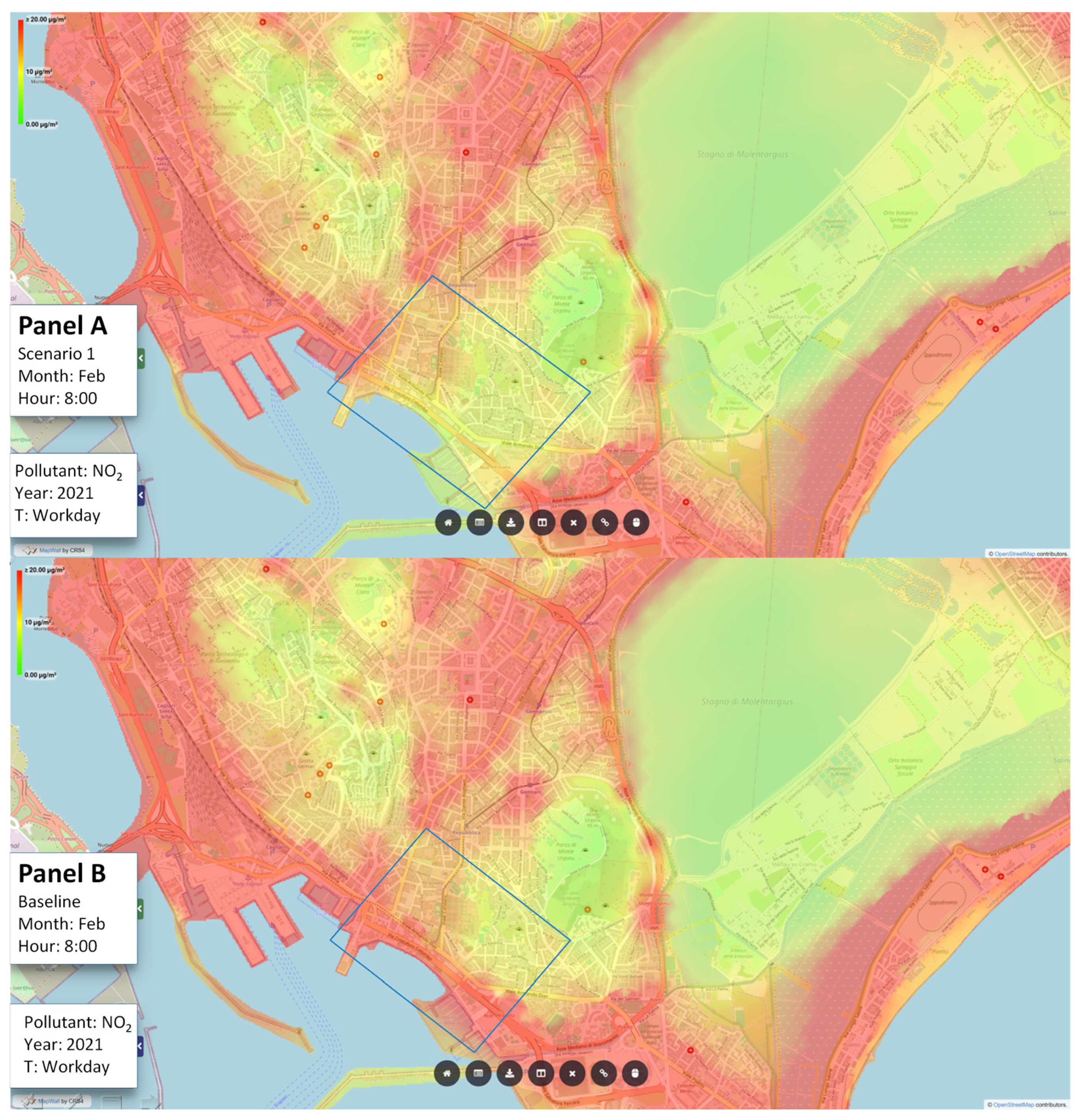
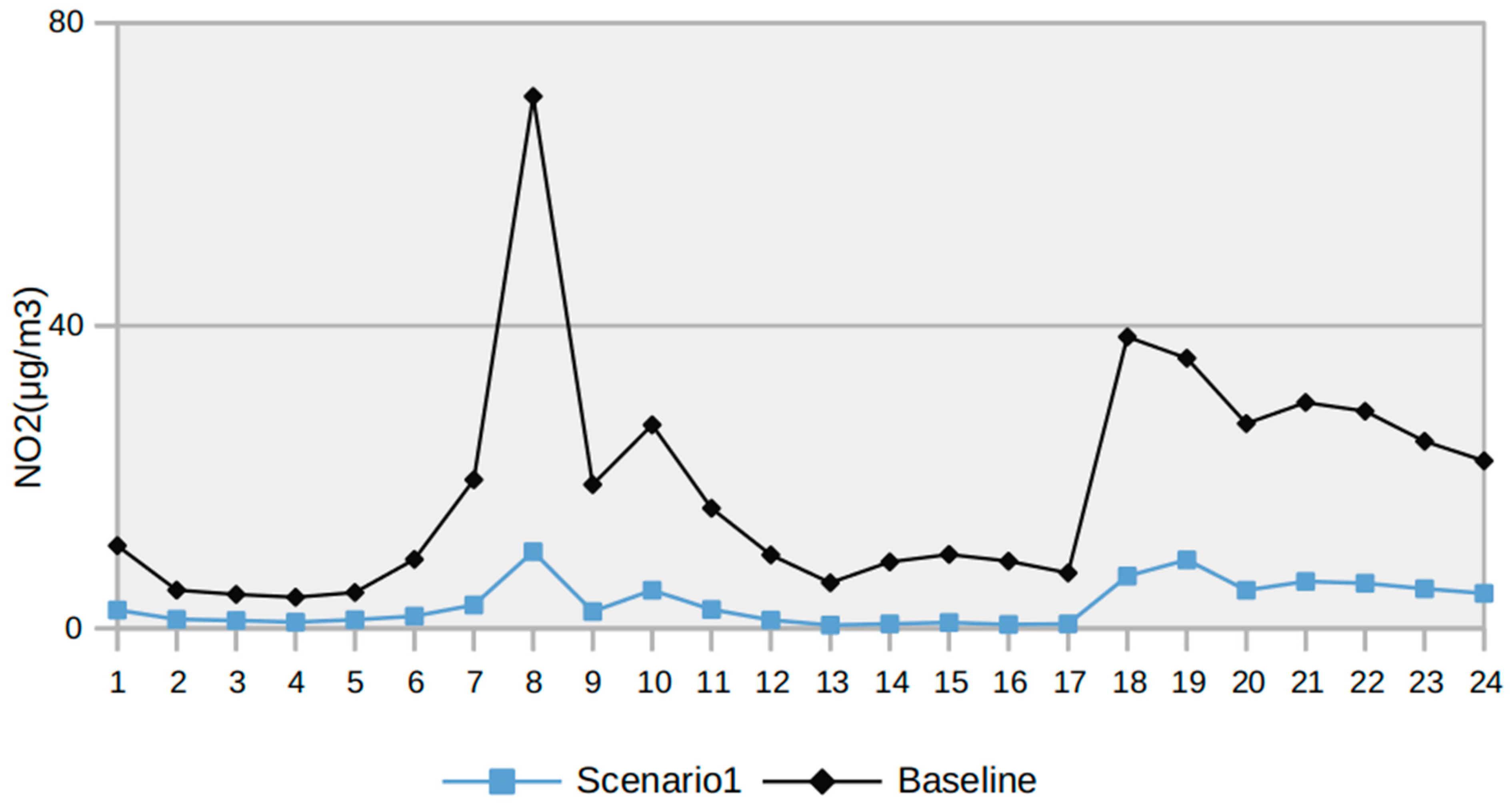
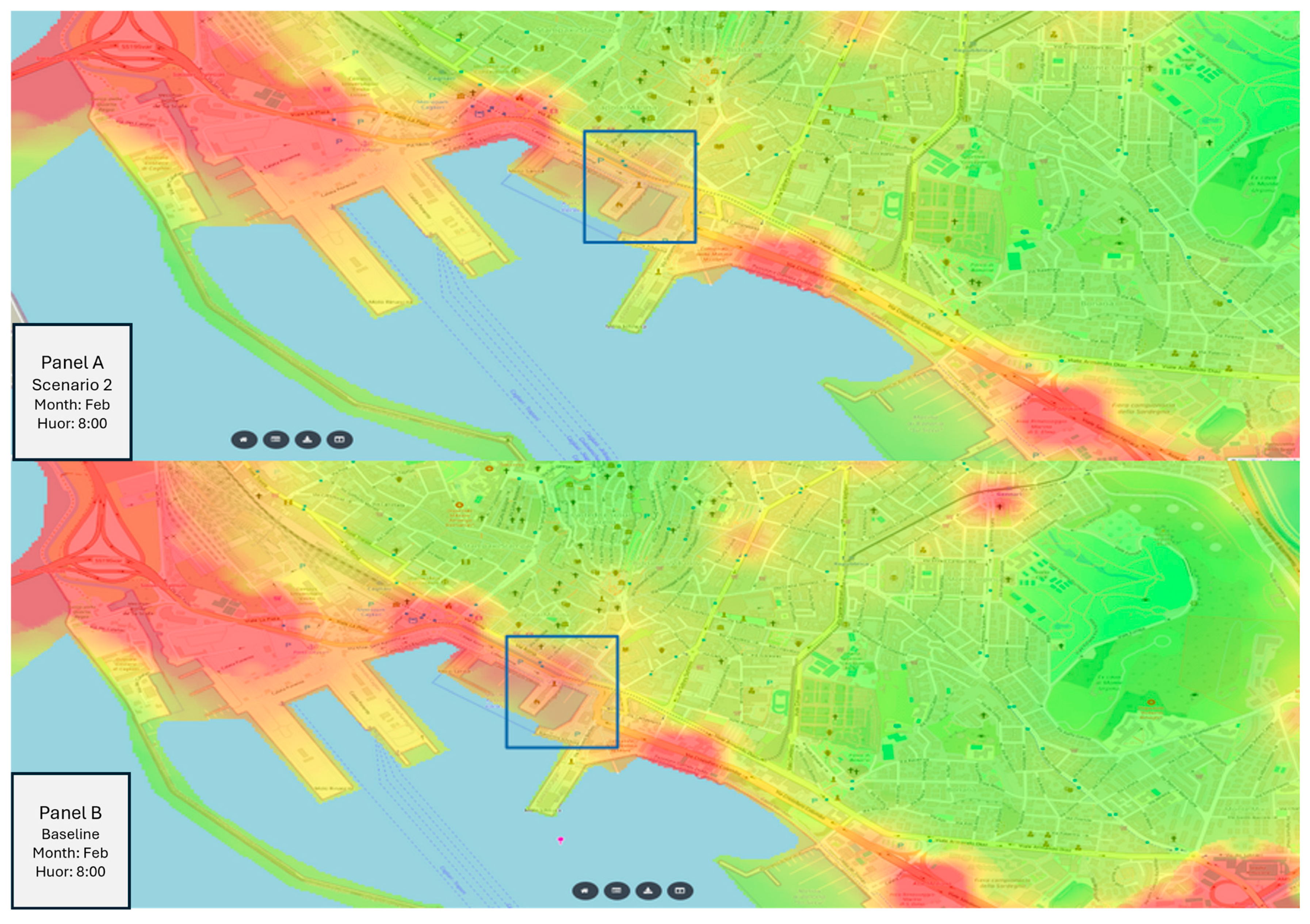
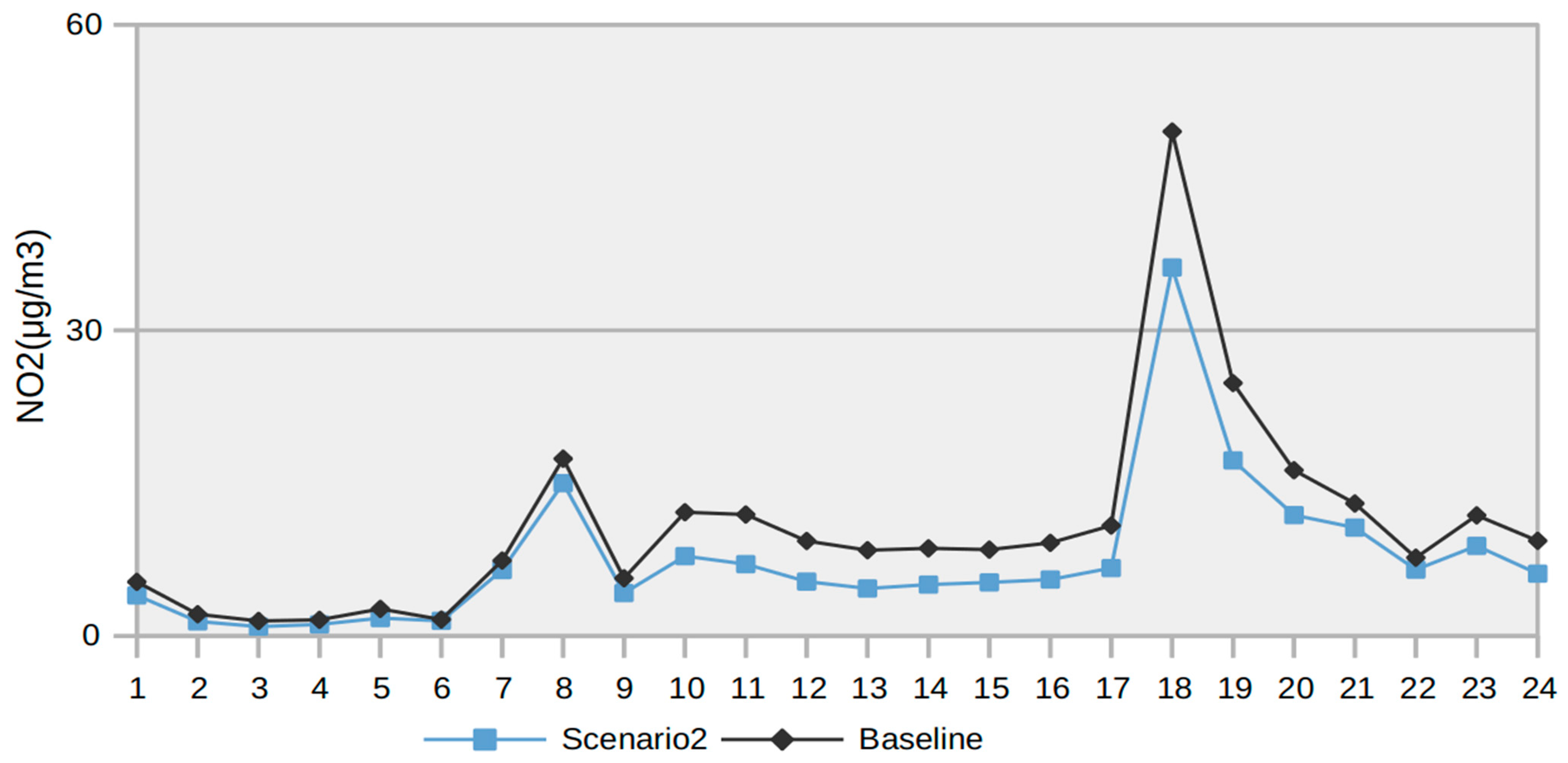
| Current Limit | New Limit | Change | |
|---|---|---|---|
| PM2.5 | 25 µg/m3 | 10 µg/m3 | 60% |
| PM10 | 40 µg/m3 | 20 µg/m3 | 50% |
| NO2 | 40 µg/m3 | 20 µg/m3 | 50% |
| CO | 10 mg/m3 | 5 mg/m3 | 50% |
| Parameter | Value | Source Notes |
|---|---|---|
| Registered vehicles | 131,742 | MIT [37] |
| Circulating insured vehicles | 90,881 | MIT [37] |
| Average CO2 emission/km | 130.3 g/km | Weighted average based on fleet composition |
| Public buses (articulated) | 13 | CTM S.p.A. fleet |
| Trolley buses | 32 | CTM S.p.A. fleet |
| Main industrial areas (hectares) | 9244 | CASIC |
| Annual passengers (Mameli Airport) | 2.7 million (2021) | SOGAER |
| Cargo throughput (Port of Cagliari) | ~50 million tons annually | Port Authority |
| MSEP | MSE | R2 | |
|---|---|---|---|
| First Run—Summer | 3.23 | 44.47 | 0.71 |
| Best Run—Summer | 1.42 | 21.5 | 0.72 |
| First Run—Autumn | 3.15 | 79.49 | 0.70 |
| Best Run—Autumn | 1.71 | 62.53 | 0.73 |
| First Run—Winter | 4.49 | 135.33 | 0.71 |
| Best Run—Winter | 1.25 | 36.03 | 0.72 |
| First Run—Spring | 3.32 | 66.04 | 0.71 |
| Best Run—Spring | 1.09 | 27.64 | 0.74 |
Disclaimer/Publisher’s Note: The statements, opinions and data contained in all publications are solely those of the individual author(s) and contributor(s) and not of MDPI and/or the editor(s). MDPI and/or the editor(s) disclaim responsibility for any injury to people or property resulting from any ideas, methods, instructions or products referred to in the content. |
© 2025 by the authors. Licensee MDPI, Basel, Switzerland. This article is an open access article distributed under the terms and conditions of the Creative Commons Attribution (CC BY) license (https://creativecommons.org/licenses/by/4.0/).
Share and Cite
Satta, G.; Cau, P.; Muroni, D.; Milesi, C.; Casari, C. AERQ: Leveraging IoT and HPC for Urban Air Quality Monitoring. Gases 2025, 5, 25. https://doi.org/10.3390/gases5040025
Satta G, Cau P, Muroni D, Milesi C, Casari C. AERQ: Leveraging IoT and HPC for Urban Air Quality Monitoring. Gases. 2025; 5(4):25. https://doi.org/10.3390/gases5040025
Chicago/Turabian StyleSatta, Guido, Pierluigi Cau, Davide Muroni, Carlo Milesi, and Carlino Casari. 2025. "AERQ: Leveraging IoT and HPC for Urban Air Quality Monitoring" Gases 5, no. 4: 25. https://doi.org/10.3390/gases5040025
APA StyleSatta, G., Cau, P., Muroni, D., Milesi, C., & Casari, C. (2025). AERQ: Leveraging IoT and HPC for Urban Air Quality Monitoring. Gases, 5(4), 25. https://doi.org/10.3390/gases5040025






